Quoting from Alan Lightman's, "A Modern Day Yankee In A
Connecticut Court and other essays on Science".
Conversations with Papa Joe
The Third Evening
Read: Conversations_with_Papa_Joe_III.pdf
Listen: Conversations_with_Papa_Joe_III.mp3
Key Words and Phrases:
Stars held together by Gravity
Stellar creation
Hydrogen Fusion
P-P-Chain
Solar Neutrinos
Helium Fusion
White Dwarf
Neutron Stars (Pulsars)
Black Holes
Space Telescopes (EM)
Instruments
Accretion Disks
Equations (General Relative and the Quantum Mechanics)
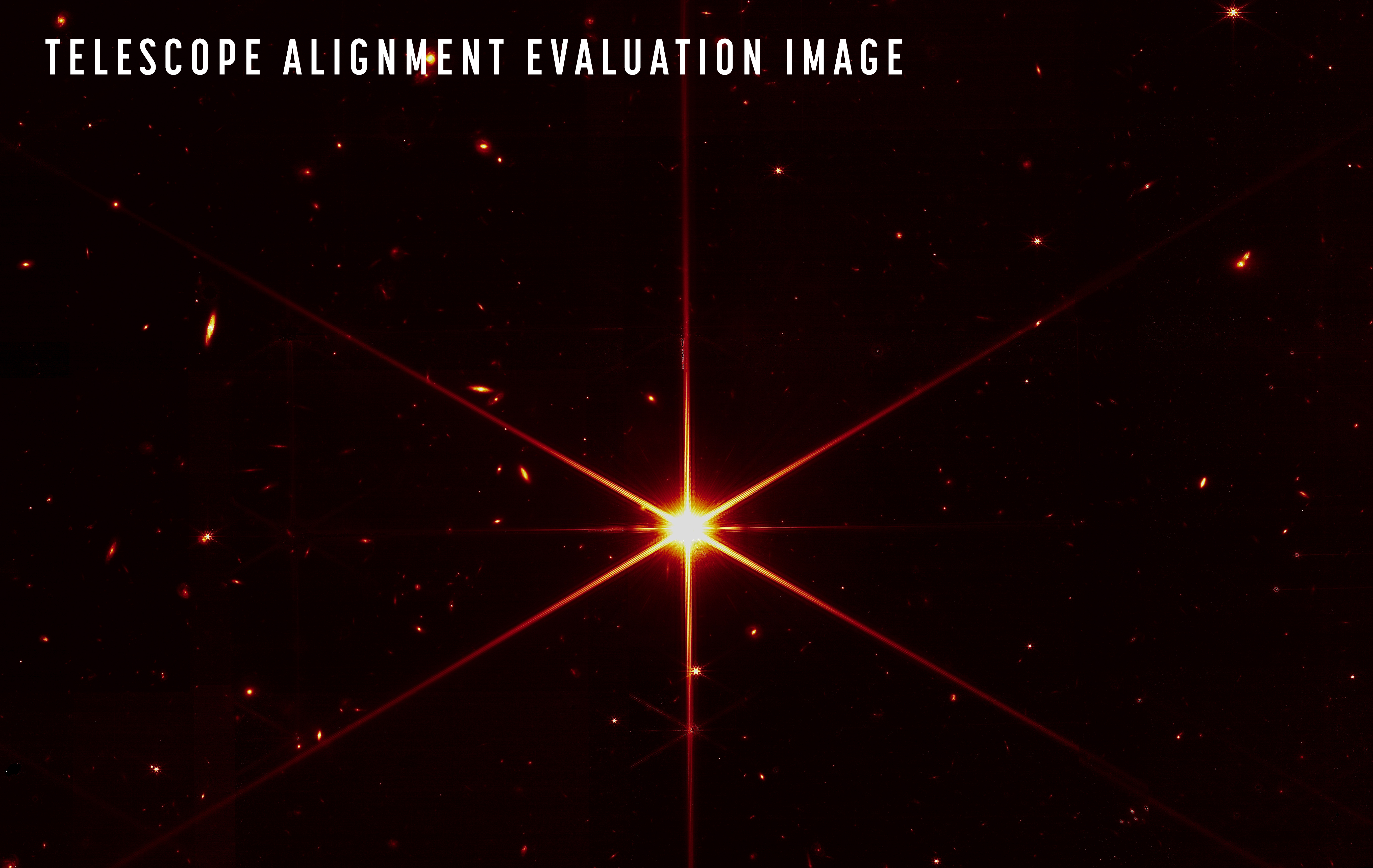 Choose Something Like a Star - Randall Thompson
https://www.youtube.com/watch?v=LNDrMifZqLU
Choose Something Like a Star - Robert Frost
O star (the fairest one in sight),
We grant your loftiness the right
To some obscurity of cloud-
It will not do to say of night,
Since dark is what brings out your
light.
Some mystery becomes the proud.
But to be wholly taciturn
In your reserve is not allowed.
Say something to us we can learn
By heart and when alone repeat.
Say something! And it says "I burn."
But say with what degree of heat.
Talk Fahrenheit, talk Centigrade.
Use language we can comprehend.
Tell us what elements you blend.
It gives us strangely little aid,
But does tell something in the end.
And steadfast as Keats Eremite,
Not even stooping from its sphere,
It asks a little of us here.
It asks of us a certain height,
So when at times the mob is swayed
To carry praise or blame too far,
We may choose something like a star
To stay our minds on and be staid.
Choose Something Like a Star - Randall Thompson
https://www.youtube.com/watch?v=LNDrMifZqLU
Choose Something Like a Star - Robert Frost
O star (the fairest one in sight),
We grant your loftiness the right
To some obscurity of cloud-
It will not do to say of night,
Since dark is what brings out your
light.
Some mystery becomes the proud.
But to be wholly taciturn
In your reserve is not allowed.
Say something to us we can learn
By heart and when alone repeat.
Say something! And it says "I burn."
But say with what degree of heat.
Talk Fahrenheit, talk Centigrade.
Use language we can comprehend.
Tell us what elements you blend.
It gives us strangely little aid,
But does tell something in the end.
And steadfast as Keats Eremite,
Not even stooping from its sphere,
It asks a little of us here.
It asks of us a certain height,
So when at times the mob is swayed
To carry praise or blame too far,
We may choose something like a star
To stay our minds on and be staid.
WHAT ARE STARS?
Wikipedia - Star
https://en.wikipedia.org/wiki/Star
A star is an astronomical object consisting of a luminous
spheroid of plasma held together by its own gravity. The
nearest star to Earth is the Sun. Many other stars are
visible to the naked eye from Earth during the night,
appearing as a multitude of fixed luminous points in the sky
due to their immense distance from Earth. Historically, the
most prominent stars were grouped into constellations and
asterisms, the brightest of which gained proper names.
Astronomers have assembled star catalogues that identify the
known stars and provide standardized stellar designations.
The observable Universe contains an estimated 10^24 stars,
but most are invisible to the naked eye from Earth,
including all stars outside our galaxy, the Milky Way.
For most of its active life, a star shines due to
thermonuclear fusion of hydrogen into helium in its core,
releasing energy that traverses the star's interior and then
radiates into outer space. Almost all naturally occurring
elements heavier than helium are created by stellar
nucleosynthesis during the star's lifetime, and for some
stars by supernova nucleosynthesis when it explodes. Near
the end of its life, a star can also contain degenerate
matter. Astronomers can determine the mass, age, metallicity
(chemical composition), and many other properties of a star
by observing its motion through space, its luminosity, and
spectrum respectively. The total mass of a star is the main
factor that determines its evolution and eventual fate.
Other characteristics of a star, including diameter and
temperature, change over its life, while the star's
environment affects its rotation and movement. A plot of the
temperature of many stars against their luminosities
produces a plot known as a Hertzsprung-Russell diagram (H-R
diagram). Plotting a particular star on that diagram allows
the age and evolutionary state of that star to be
determined.

FORMATION AND EVOLUTION OF STARS
Wikipedia - Formation and evolution
https://en.wikipedia.org/wiki/Star#Formation_and_evolution
Stars condense from regions of space of higher matter
density, yet those regions are less dense than within a
vacuum chamber. These regions-known as molecular
clouds-consist mostly of hydrogen, with about 23 to 28
percent helium and a few percent heavier elements. One
example of such a star-forming region is the Orion Nebula.
Most stars form in groups of dozens to hundreds of thousands
of stars. Massive stars in these groups may powerfully
illuminate those clouds, ionizing the hydrogen, and creating
H II regions. Such feedback effects, from star formation,
may ultimately disrupt the cloud and prevent further star
formation.
All stars spend the majority of their existence as main
sequence stars, fueled primarily by the nuclear fusion of
hydrogen into helium within their cores. However, stars of
different masses have markedly different properties at
various stages of their development. The ultimate fate of
more massive stars differs from that of less massive stars,
as do their luminosities and the impact they have on their
environment.
The formation of a star begins with gravitational
instability within a molecular cloud, caused by regions of
higher density-often triggered by compression of clouds by
radiation from massive stars, expanding bubbles in the
interstellar medium, the collision of different molecular
clouds, or the collision of galaxies (as in a starburst
galaxy). When a region reaches a sufficient density of
matter to satisfy the criteria for Jeans instability, it
begins to collapse under its own gravitational force.
As the cloud collapses, individual conglomerations of dense
dust and gas form "Bok globules". As a globule collapses and
the density increases, the gravitational energy converts
into heat and the temperature rises. When the protostellar
cloud has approximately reached the stable condition of
hydrostatic equilibrium, a protostar forms at the core.
These pre-main-sequence stars are often surrounded by a
protoplanetary disk and powered mainly by the conversion of
gravitational energy. The period of gravitational
contraction lasts about 10 to 15 million years.
Breathtaking Hubble Image Captures a Star That's Still Being
Born
https://www.sciencealert.com/this-stellar-nursery-snapped-by-hubble-shows-a-star-still-being-born
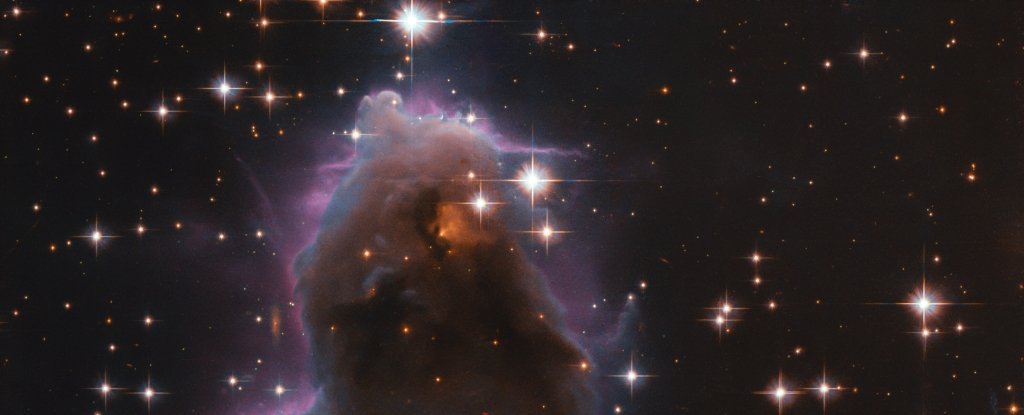 Wikipedia - Sun
https://en.wikipedia.org/wiki/Sun
The Sun is the star at the center of the Solar System. It is
a nearly perfect sphere of hot plasma, heated to
incandescence by nuclear fusion reactions in its core,
radiating the energy mainly as light and infrared radiation.
It is by far the most important source of energy for life on
Earth. Its diameter is about 1.39 million kilometers
(864,000 miles), or 109 times that of Earth, and its mass is
about 330,000 times that of Earth. It accounts for about
99.86% of the total mass of the Solar System. Roughly three
quarters of the Sun's mass consists of hydrogen (~73%); the
rest is mostly helium (~25%), with much smaller quantities
of heavier elements, including oxygen, carbon, neon, and
iron.
Wikipedia - Sun
https://en.wikipedia.org/wiki/Sun
The Sun is the star at the center of the Solar System. It is
a nearly perfect sphere of hot plasma, heated to
incandescence by nuclear fusion reactions in its core,
radiating the energy mainly as light and infrared radiation.
It is by far the most important source of energy for life on
Earth. Its diameter is about 1.39 million kilometers
(864,000 miles), or 109 times that of Earth, and its mass is
about 330,000 times that of Earth. It accounts for about
99.86% of the total mass of the Solar System. Roughly three
quarters of the Sun's mass consists of hydrogen (~73%); the
rest is mostly helium (~25%), with much smaller quantities
of heavier elements, including oxygen, carbon, neon, and
iron.
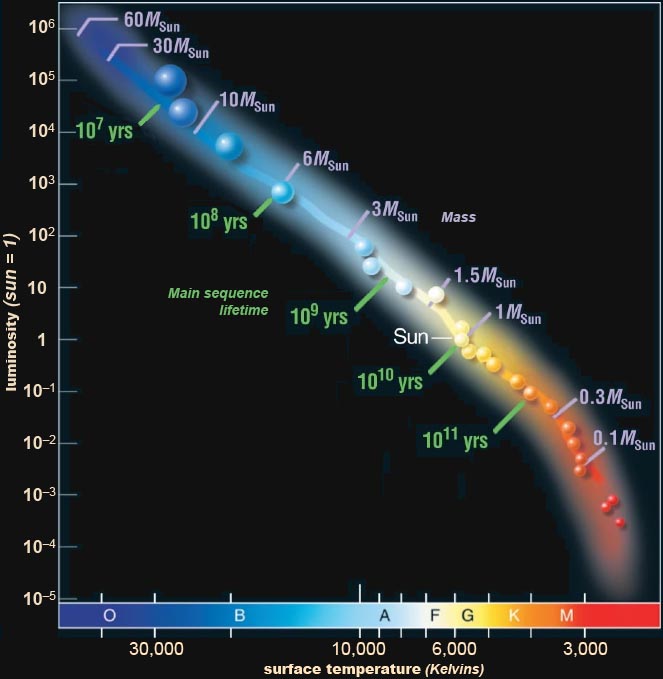 The Sun is a G-type main-sequence star (G2V) based on its
spectral class. As such, it is informally and not completely
accurately referred to as a yellow dwarf (its light is
closer to white than yellow). It formed approximately 4.6
billion years ago from the gravitational collapse of matter
within a region of a large molecular cloud. Most of this
matter gathered in the center, whereas the rest flattened
into an orbiting disk that became the Solar System. The
central mass became so hot and dense that it eventually
initiated nuclear fusion in its core. It is thought that
almost all stars form by this process.
The Sun currently fuses about 600 million tons of hydrogen
into helium every second, converting 4 million tons of
matter into energy every second as a result. This energy,
which can take between 10,000 and 170,000 years to escape
from its core, is the source of the Sun's light and heat.
When hydrogen fusion in its core has diminished to the point
at which the Sun is no longer in hydrostatic equilibrium,
its core will undergo a marked increase in density and
temperature while its outer layers expand, eventually
transforming the Sun into a red giant. It is calculated that
the Sun will become sufficiently large to engulf the current
orbits of Mercury and Venus, and render Earth uninhabitable
- but not for about five billion years. After this, it will
shed its outer layers and become a dense type of cooling
star known as a white dwarf, and no longer produce energy by
fusion, but still glow and give off heat from its previous
fusion.
STELLAR FUSION PROCESES
In the past decade neutrino detectors have become much for
efficient. Modern detectors are also able to detect not just
the energy of a neutrino, but also its flavor.
We now know that the solar neutrinos detected from early
experiments come not from the common pp-chain neutrinos, but
from secondary reactions such as boron decay, which create
higher energy neutrinos that are easier to detect.
Then in 2014, a team detected low-energy neutrinos directly
produced by the pp-chain. Their observations confirmed that
99 percent of the Sun's energy is generated by proton-proton
fusion.
Proton-proton chain CNO cycle
The Sun is a G-type main-sequence star (G2V) based on its
spectral class. As such, it is informally and not completely
accurately referred to as a yellow dwarf (its light is
closer to white than yellow). It formed approximately 4.6
billion years ago from the gravitational collapse of matter
within a region of a large molecular cloud. Most of this
matter gathered in the center, whereas the rest flattened
into an orbiting disk that became the Solar System. The
central mass became so hot and dense that it eventually
initiated nuclear fusion in its core. It is thought that
almost all stars form by this process.
The Sun currently fuses about 600 million tons of hydrogen
into helium every second, converting 4 million tons of
matter into energy every second as a result. This energy,
which can take between 10,000 and 170,000 years to escape
from its core, is the source of the Sun's light and heat.
When hydrogen fusion in its core has diminished to the point
at which the Sun is no longer in hydrostatic equilibrium,
its core will undergo a marked increase in density and
temperature while its outer layers expand, eventually
transforming the Sun into a red giant. It is calculated that
the Sun will become sufficiently large to engulf the current
orbits of Mercury and Venus, and render Earth uninhabitable
- but not for about five billion years. After this, it will
shed its outer layers and become a dense type of cooling
star known as a white dwarf, and no longer produce energy by
fusion, but still glow and give off heat from its previous
fusion.
STELLAR FUSION PROCESES
In the past decade neutrino detectors have become much for
efficient. Modern detectors are also able to detect not just
the energy of a neutrino, but also its flavor.
We now know that the solar neutrinos detected from early
experiments come not from the common pp-chain neutrinos, but
from secondary reactions such as boron decay, which create
higher energy neutrinos that are easier to detect.
Then in 2014, a team detected low-energy neutrinos directly
produced by the pp-chain. Their observations confirmed that
99 percent of the Sun's energy is generated by proton-proton
fusion.
Proton-proton chain CNO cycle
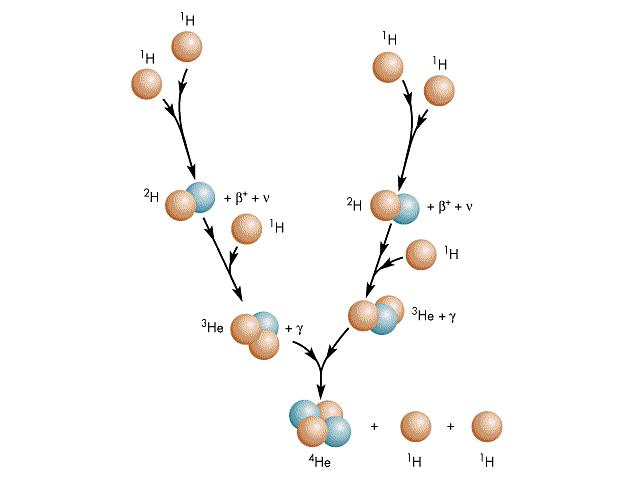
 Neutrinos Prove Our Sun Is Undergoing a Second Type of Fusion
in Its Core
https://www.sciencealert.com/neutrinos-prove-the-sun-is-doing-a-second-kind-of-fusion-in-its-core
Neutrinos Prove Our Sun Is Undergoing a Second Type of Fusion
in Its Core
https://www.sciencealert.com/neutrinos-prove-the-sun-is-doing-a-second-kind-of-fusion-in-its-core
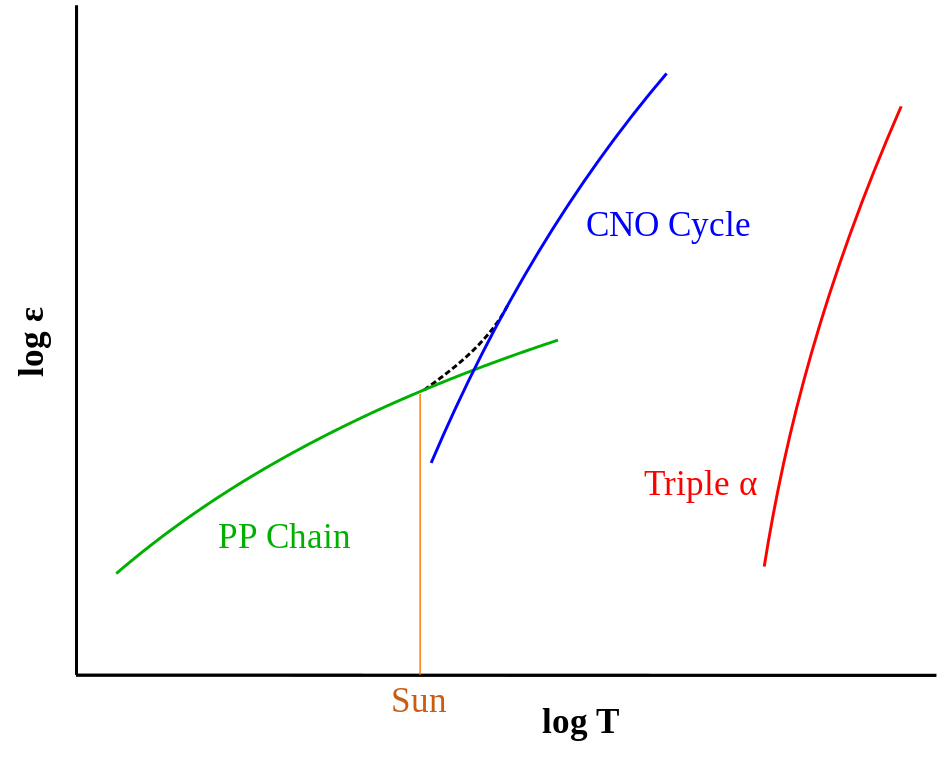
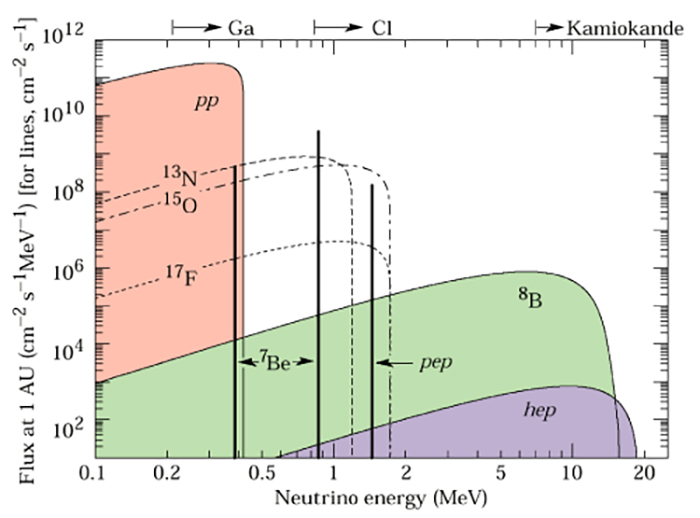 While the pp-chain dominates fusion in the Sun, our star is
large enough that the CNO cycle should occur at a low level.
It should be what accounts for that extra 1 percent of the
energy produced by the Sun.
But because CNO neutrinos are rare, they are difficult to
detect. But recently a team successfully observed them.
One of the biggest challenges with detecting CNO neutrinos
is that their signal tends to be buried within terrestrial
neutrino noise. Nuclear fusion doesn't occur naturally on
Earth, but low levels of radioactive decay from terrestrial
rocks can trigger events in a neutrino detector that are
similar to CNO neutrino detections.
So the team created a sophisticated analysis process that
filters the neutrino signal from false positives. Their
study confirms that CNO fusion occurs within our Sun at
predicted levels.
Triple-alpha Process (Helium-Burning)
https://en.wikipedia.org/wiki/Triple-alpha_process
Carbon-Burning Process
https://en.wikipedia.org/wiki/Carbon-burning_process
Neon-Burning Process
https://en.wikipedia.org/wiki/Neon-burning_process
Oxygen-Burning Process (0.01-5 years)
https://en.wikipedia.org/wiki/Oxygen-burning_process
Silicon-Burning Process (1 day)
https://en.wikipedia.org/wiki/Silicon-burning_process
r-process
https://en.wikipedia.org/wiki/R-process
What Happens If A Star Explodes Near The Earth?
https://www.youtube.com/watch?v=evUfG3lrk5U
While the pp-chain dominates fusion in the Sun, our star is
large enough that the CNO cycle should occur at a low level.
It should be what accounts for that extra 1 percent of the
energy produced by the Sun.
But because CNO neutrinos are rare, they are difficult to
detect. But recently a team successfully observed them.
One of the biggest challenges with detecting CNO neutrinos
is that their signal tends to be buried within terrestrial
neutrino noise. Nuclear fusion doesn't occur naturally on
Earth, but low levels of radioactive decay from terrestrial
rocks can trigger events in a neutrino detector that are
similar to CNO neutrino detections.
So the team created a sophisticated analysis process that
filters the neutrino signal from false positives. Their
study confirms that CNO fusion occurs within our Sun at
predicted levels.
Triple-alpha Process (Helium-Burning)
https://en.wikipedia.org/wiki/Triple-alpha_process
Carbon-Burning Process
https://en.wikipedia.org/wiki/Carbon-burning_process
Neon-Burning Process
https://en.wikipedia.org/wiki/Neon-burning_process
Oxygen-Burning Process (0.01-5 years)
https://en.wikipedia.org/wiki/Oxygen-burning_process
Silicon-Burning Process (1 day)
https://en.wikipedia.org/wiki/Silicon-burning_process
r-process
https://en.wikipedia.org/wiki/R-process
What Happens If A Star Explodes Near The Earth?
https://www.youtube.com/watch?v=evUfG3lrk5U
GRAVITY EVENTUALLY WINS
Star are born and stars die... just like us. The big massive
stars have but short lives, a few millions of years. Stars
like our sun last for a good 10 billions of years, and the
little red stars like Barnard's Star might last for 100s of
billions of years. How long stars live, is determined by
their mass (which must be at least 80 Jupiter masses to
sustain thermonuclear fusion of hydrogen).
There are four (4) fates for the end of stars depending on
their masses and the masses of their cores:
Red/Brown Dwarf - less than 0.076 Ms <== Main Sequence 0.076-0.8 Ms
Stars less than about 0.6 solar masses, when nuclear fuel is
used up, gravitational collapse shrinks the star, but no
more than the gas temperature-pressure-volume laws of
classical physics allow. We have not found any white dwarf
less massive than 0.6 solar masses. Part of the answer is
that the universe may not be old enough for lower mass stars
to have evolved off the main sequence.
White Dwarf - 0.08 and 1.44 Ms <== Main Sequence 0.8-8 Ms
Stars with core masses between 0.08 and 1.44 solar masses
are destined to become white dwarfs. White dwarfs are
degenerate matter. Further collapse is halted by electron
degeneracy pressure. The vast majority of stars are in this
mass range and are destined to become white dwarfs.
Neutron Star - 1.44 and 2.35 Ms <== Main Sequence 8-30 Ms
Core masses between 1.44 and 2.35 solar masses overcome
electron degeneracy pressure and collapse to form neutron
stars, a star that is essentially one gigantic nucleus.
Further collapse is halted by neutron degeneracy pressure.
Black Hole - ~2.4 or more Ms <== Main Sequence > 30 Ms
But for cores with mass of ~2.4 or more solar masses, neutron
degeneracy pressure does not stop the collapse and the star
becomes a black hole with zero physical size, but with all
the mass. Gravity really wins!
In each case, gravity eventually wins. But, to what extent
is determined by the mass and the relative pressures of the
quantum mechanical forces, electron and neutron degeneracy
pressure.
What Happens If A Star Explodes Near The Earth?
https://www.youtube.com/watch?v=evUfG3lrk5U
Degenerate matter
https://en.wikipedia.org/wiki/Degenerate_matter
Degenerate matter is a highly dense state of fermionic
matter in which particles must occupy high states of kinetic
energy to satisfy the Pauli exclusion principle. The
description applies to matter composed of electrons,
protons, neutrons or other fermions. The term is mainly used
in astrophysics to refer to dense stellar objects where
gravitational pressure is so extreme that quantum mechanical
effects are significant. This type of matter is naturally
found in stars in their final evolutionary states, such as
white dwarfs and neutron stars, where thermal pressure alone
is not enough to avoid gravitational collapse.
Degenerate matter is usually modelled as an ideal Fermi gas,
an ensemble of non-interacting fermions. In a quantum
mechanical description, particles limited to a finite volume
may take only a discrete set of energies, called quantum
states. The Pauli exclusion principle prevents identical
fermions from occupying the same quantum state. At lowest
total energy (when the thermal energy of the particles is
negligible), all the lowest energy quantum states are
filled. This state is referred to as full degeneracy. This
degeneracy pressure remains non-zero even at absolute zero
temperature. Adding particles or reducing the volume forces
the particles into higher-energy quantum states. In this
situation, a compression force is required, and is made
manifest as a resisting pressure. The key feature is that
this degeneracy pressure does not depend on the temperature
but only on the density of the fermions. Degeneracy pressure
keeps dense stars in equilibrium, independent of the thermal
structure of the star.
A degenerate mass whose fermions have velocities close to
the speed of light (particle energy larger than its rest
mass energy) is called relativistic degenerate matter.
The concept of degenerate stars, stellar objects composed of
degenerate matter, was originally developed in a joint
effort between Arthur Eddington, Ralph Fowler and Arthur
Milne. Eddington had suggested that the atoms in Sirius B
were almost completely ionized and closely packed. Fowler
described white dwarfs as composed of a gas of particles
that became degenerate at low temperature. Milne proposed
that degenerate matter is found in most of the nuclei of
stars, not only in compact stars.
WHERE DO THE ELEMENTS COME FROM?
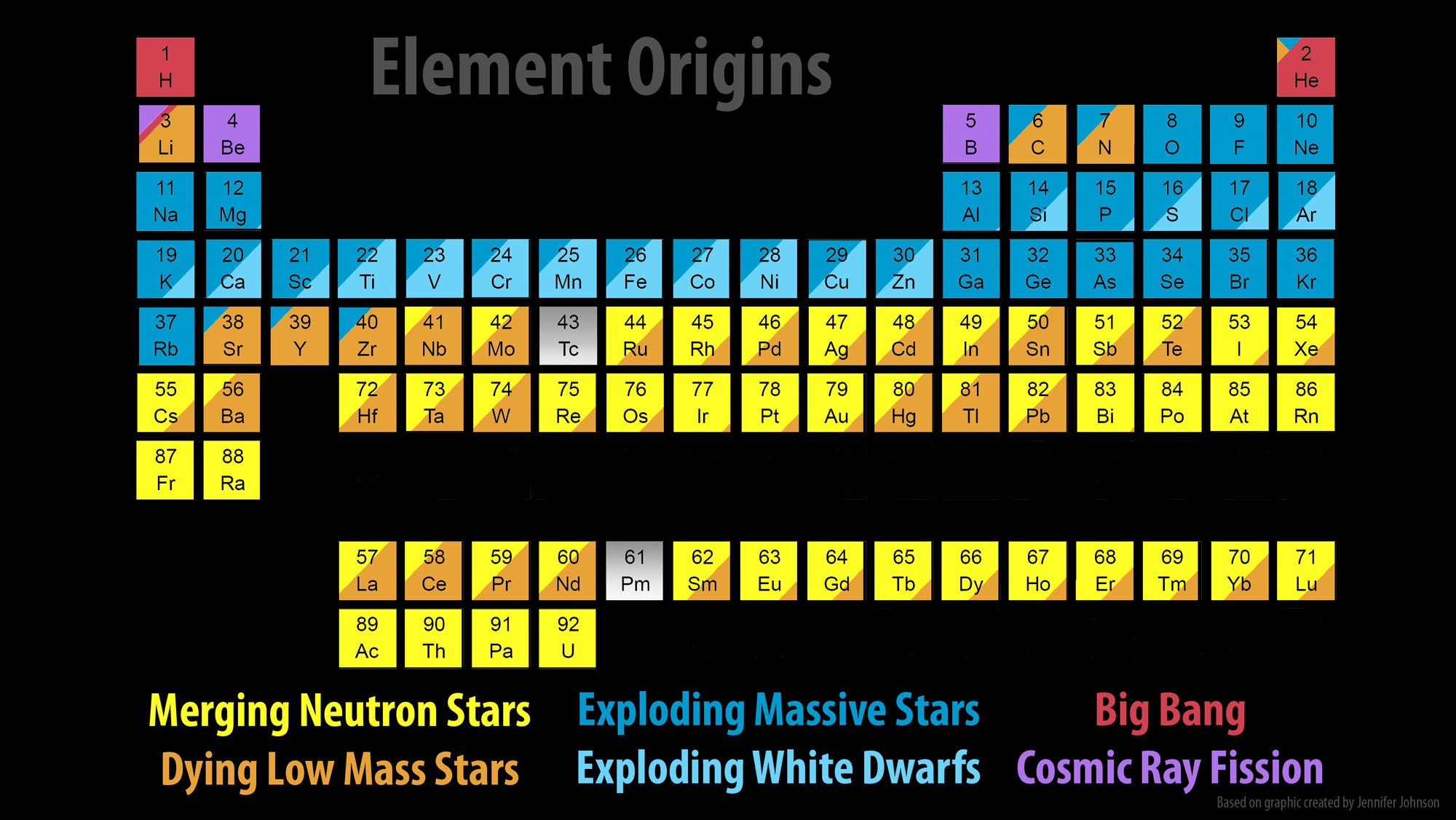 R-process
https://en.wikipedia.org/wiki/R-process
In nuclear astrophysics, the rapid neutron-capture process,
also known as the r-process, is a set of nuclear reactions
that is responsible for the creation of approximately half
of the atomic nuclei heavier than iron; the "heavy
elements", with the other half produced by the p-process
and s-process. The r-process usually synthesizes the most
neutron-rich stable isotopes of each heavy element. The
r-process can typically synthesize the heaviest four
isotopes of every heavy element, and the two heaviest
isotopes, which are referred to as r-only nuclei, can only
be created via the r-process.
P-process
https://en.wikipedia.org/wiki/P-process
The term p-process (p for proton) is used in two ways in
the scientific literature concerning the astrophysical
origin of the elements (nucleosynthesis). Originally it
referred to a proton capture process which is the source of
certain, naturally occurring, neutron-deficient isotopes of
the elements from selenium to mercury. These nuclides are
called p-nuclei and their origin is still not completely
understood. Although it was shown that the originally
suggested process cannot produce the p-nuclei, later on the
term p-process was sometimes used to generally refer to any
nucleosynthesis process supposed to be responsible for the
p-nuclei.
S-process
https://en.wikipedia.org/wiki/S-process
The slow neutron-capture process, or s-process, is a series
of reactions in nuclear astrophysics that occur in stars,
particularly AGB stars. The s-process is responsible for the
creation (nucleosynthesis) of approximately half the atomic
nuclei heavier than iron.
In the s-process, a seed nucleus undergoes neutron capture
to form an isotope with one higher atomic mass. If the new
isotope is stable, a series of increases in mass can occur,
but if it is unstable, then beta decay will occur, producing
an element of the next higher atomic number. The process is
slow (hence the name) in the sense that there is sufficient
time for this radioactive decay to occur before another
neutron is captured. A series of these reactions produces
stable isotopes by moving along the valley of beta-decay
stable isobars in the table of nuclides.
A range of elements and isotopes can be produced by the
s-process, because of the intervention of alpha decay steps
along the reaction chain. The relative abundances of
elements and isotopes produced depends on the source of the
neutrons and how their flux changes over time. Each branch
of the s-process reaction chain eventually terminates at a
cycle involving lead, bismuth, and polonium.
R-process
https://en.wikipedia.org/wiki/R-process
In nuclear astrophysics, the rapid neutron-capture process,
also known as the r-process, is a set of nuclear reactions
that is responsible for the creation of approximately half
of the atomic nuclei heavier than iron; the "heavy
elements", with the other half produced by the p-process
and s-process. The r-process usually synthesizes the most
neutron-rich stable isotopes of each heavy element. The
r-process can typically synthesize the heaviest four
isotopes of every heavy element, and the two heaviest
isotopes, which are referred to as r-only nuclei, can only
be created via the r-process.
P-process
https://en.wikipedia.org/wiki/P-process
The term p-process (p for proton) is used in two ways in
the scientific literature concerning the astrophysical
origin of the elements (nucleosynthesis). Originally it
referred to a proton capture process which is the source of
certain, naturally occurring, neutron-deficient isotopes of
the elements from selenium to mercury. These nuclides are
called p-nuclei and their origin is still not completely
understood. Although it was shown that the originally
suggested process cannot produce the p-nuclei, later on the
term p-process was sometimes used to generally refer to any
nucleosynthesis process supposed to be responsible for the
p-nuclei.
S-process
https://en.wikipedia.org/wiki/S-process
The slow neutron-capture process, or s-process, is a series
of reactions in nuclear astrophysics that occur in stars,
particularly AGB stars. The s-process is responsible for the
creation (nucleosynthesis) of approximately half the atomic
nuclei heavier than iron.
In the s-process, a seed nucleus undergoes neutron capture
to form an isotope with one higher atomic mass. If the new
isotope is stable, a series of increases in mass can occur,
but if it is unstable, then beta decay will occur, producing
an element of the next higher atomic number. The process is
slow (hence the name) in the sense that there is sufficient
time for this radioactive decay to occur before another
neutron is captured. A series of these reactions produces
stable isotopes by moving along the valley of beta-decay
stable isobars in the table of nuclides.
A range of elements and isotopes can be produced by the
s-process, because of the intervention of alpha decay steps
along the reaction chain. The relative abundances of
elements and isotopes produced depends on the source of the
neutrons and how their flux changes over time. Each branch
of the s-process reaction chain eventually terminates at a
cycle involving lead, bismuth, and polonium.
BOOK RECOMMENDATION
Astrophysical Formulae: Radiation, Gas Processes, and
High Energy Physics (Volume 1)
bu Kenneth R. Lang
https://www.amazon.com/Astrophysical-Formulae-Radiation-Processes-Astrophysics/dp/3540296921/
Astrophysical Formulae: Space, Time, Matter, and
Cosmology (Volume 2)
by Kenneth Lang
https://www.amazon.com/Astrophysical-Formulae-Space-Matter-Cosmology/dp/3540646647
Astrophysical Formulae is a comprehensive, widely-used
reference to the fundamental formulae employed in astronomy,
astrophysics and general physics. All the basic formulae in
a particular field are given, with references to both the
original work and recent research papers. Where possible the
formulae have been developed from basic principles. If you
want to know something about a given area, or find the
formula that you need or know might exist, the first step is
to look for it in Astrophysical Formulae or its references,
rather than searching through a library or journals.
Over the past two decades, Astrophysical Formulae has become
a standard reference found on numerous individual
bookshelves and in all libraries that deal with astronomy,
astrophysics and physics. This third, enlarged and revised
edition will be similarly used by current and future
generations of students and scientists in these fields.
The new edition of Astrophysical Formulae has been divided
into two books - Volume I. Radiation, Gas Processes and High
Energy Astrophysics and Volume II. Space, Time, Matter and
Cosmology. They together contain over 4000 formulae and 5000
references, more than doubling the number found in previous
versions. Past editions have also been improved upon by
collecting all the references together in one alphabetical
bibliography, instead of listing by chapter, and numerous
references have been added for papers published during the
past three decades.
sam.wormley@icloud.com
Choose Something Like a Star - Randall Thompson https://www.youtube.com/watch?v=LNDrMifZqLU Choose Something Like a Star - Robert Frost O star (the fairest one in sight), We grant your loftiness the right To some obscurity of cloud- It will not do to say of night, Since dark is what brings out your light. Some mystery becomes the proud. But to be wholly taciturn In your reserve is not allowed. Say something to us we can learn By heart and when alone repeat. Say something! And it says "I burn." But say with what degree of heat. Talk Fahrenheit, talk Centigrade. Use language we can comprehend. Tell us what elements you blend. It gives us strangely little aid, But does tell something in the end. And steadfast as Keats Eremite, Not even stooping from its sphere, It asks a little of us here. It asks of us a certain height, So when at times the mob is swayed To carry praise or blame too far, We may choose something like a star To stay our minds on and be staid.

Wikipedia - Sun https://en.wikipedia.org/wiki/Sun The Sun is the star at the center of the Solar System. It is a nearly perfect sphere of hot plasma, heated to incandescence by nuclear fusion reactions in its core, radiating the energy mainly as light and infrared radiation. It is by far the most important source of energy for life on Earth. Its diameter is about 1.39 million kilometers (864,000 miles), or 109 times that of Earth, and its mass is about 330,000 times that of Earth. It accounts for about 99.86% of the total mass of the Solar System. Roughly three quarters of the Sun's mass consists of hydrogen (~73%); the rest is mostly helium (~25%), with much smaller quantities of heavier elements, including oxygen, carbon, neon, and iron.
The Sun is a G-type main-sequence star (G2V) based on its spectral class. As such, it is informally and not completely accurately referred to as a yellow dwarf (its light is closer to white than yellow). It formed approximately 4.6 billion years ago from the gravitational collapse of matter within a region of a large molecular cloud. Most of this matter gathered in the center, whereas the rest flattened into an orbiting disk that became the Solar System. The central mass became so hot and dense that it eventually initiated nuclear fusion in its core. It is thought that almost all stars form by this process. The Sun currently fuses about 600 million tons of hydrogen into helium every second, converting 4 million tons of matter into energy every second as a result. This energy, which can take between 10,000 and 170,000 years to escape from its core, is the source of the Sun's light and heat. When hydrogen fusion in its core has diminished to the point at which the Sun is no longer in hydrostatic equilibrium, its core will undergo a marked increase in density and temperature while its outer layers expand, eventually transforming the Sun into a red giant. It is calculated that the Sun will become sufficiently large to engulf the current orbits of Mercury and Venus, and render Earth uninhabitable - but not for about five billion years. After this, it will shed its outer layers and become a dense type of cooling star known as a white dwarf, and no longer produce energy by fusion, but still glow and give off heat from its previous fusion. STELLAR FUSION PROCESES In the past decade neutrino detectors have become much for efficient. Modern detectors are also able to detect not just the energy of a neutrino, but also its flavor. We now know that the solar neutrinos detected from early experiments come not from the common pp-chain neutrinos, but from secondary reactions such as boron decay, which create higher energy neutrinos that are easier to detect. Then in 2014, a team detected low-energy neutrinos directly produced by the pp-chain. Their observations confirmed that 99 percent of the Sun's energy is generated by proton-proton fusion. Proton-proton chain CNO cycle

Neutrinos Prove Our Sun Is Undergoing a Second Type of Fusion in Its Core https://www.sciencealert.com/neutrinos-prove-the-sun-is-doing-a-second-kind-of-fusion-in-its-core

While the pp-chain dominates fusion in the Sun, our star is large enough that the CNO cycle should occur at a low level. It should be what accounts for that extra 1 percent of the energy produced by the Sun. But because CNO neutrinos are rare, they are difficult to detect. But recently a team successfully observed them. One of the biggest challenges with detecting CNO neutrinos is that their signal tends to be buried within terrestrial neutrino noise. Nuclear fusion doesn't occur naturally on Earth, but low levels of radioactive decay from terrestrial rocks can trigger events in a neutrino detector that are similar to CNO neutrino detections. So the team created a sophisticated analysis process that filters the neutrino signal from false positives. Their study confirms that CNO fusion occurs within our Sun at predicted levels. Triple-alpha Process (Helium-Burning) https://en.wikipedia.org/wiki/Triple-alpha_process Carbon-Burning Process https://en.wikipedia.org/wiki/Carbon-burning_process Neon-Burning Process https://en.wikipedia.org/wiki/Neon-burning_process Oxygen-Burning Process (0.01-5 years) https://en.wikipedia.org/wiki/Oxygen-burning_process Silicon-Burning Process (1 day) https://en.wikipedia.org/wiki/Silicon-burning_process r-process https://en.wikipedia.org/wiki/R-process What Happens If A Star Explodes Near The Earth? https://www.youtube.com/watch?v=evUfG3lrk5U
R-process https://en.wikipedia.org/wiki/R-process In nuclear astrophysics, the rapid neutron-capture process, also known as the r-process, is a set of nuclear reactions that is responsible for the creation of approximately half of the atomic nuclei heavier than iron; the "heavy elements", with the other half produced by the p-process and s-process. The r-process usually synthesizes the most neutron-rich stable isotopes of each heavy element. The r-process can typically synthesize the heaviest four isotopes of every heavy element, and the two heaviest isotopes, which are referred to as r-only nuclei, can only be created via the r-process. P-process https://en.wikipedia.org/wiki/P-process The term p-process (p for proton) is used in two ways in the scientific literature concerning the astrophysical origin of the elements (nucleosynthesis). Originally it referred to a proton capture process which is the source of certain, naturally occurring, neutron-deficient isotopes of the elements from selenium to mercury. These nuclides are called p-nuclei and their origin is still not completely understood. Although it was shown that the originally suggested process cannot produce the p-nuclei, later on the term p-process was sometimes used to generally refer to any nucleosynthesis process supposed to be responsible for the p-nuclei. S-process https://en.wikipedia.org/wiki/S-process The slow neutron-capture process, or s-process, is a series of reactions in nuclear astrophysics that occur in stars, particularly AGB stars. The s-process is responsible for the creation (nucleosynthesis) of approximately half the atomic nuclei heavier than iron. In the s-process, a seed nucleus undergoes neutron capture to form an isotope with one higher atomic mass. If the new isotope is stable, a series of increases in mass can occur, but if it is unstable, then beta decay will occur, producing an element of the next higher atomic number. The process is slow (hence the name) in the sense that there is sufficient time for this radioactive decay to occur before another neutron is captured. A series of these reactions produces stable isotopes by moving along the valley of beta-decay stable isobars in the table of nuclides. A range of elements and isotopes can be produced by the s-process, because of the intervention of alpha decay steps along the reaction chain. The relative abundances of elements and isotopes produced depends on the source of the neutrons and how their flux changes over time. Each branch of the s-process reaction chain eventually terminates at a cycle involving lead, bismuth, and polonium.